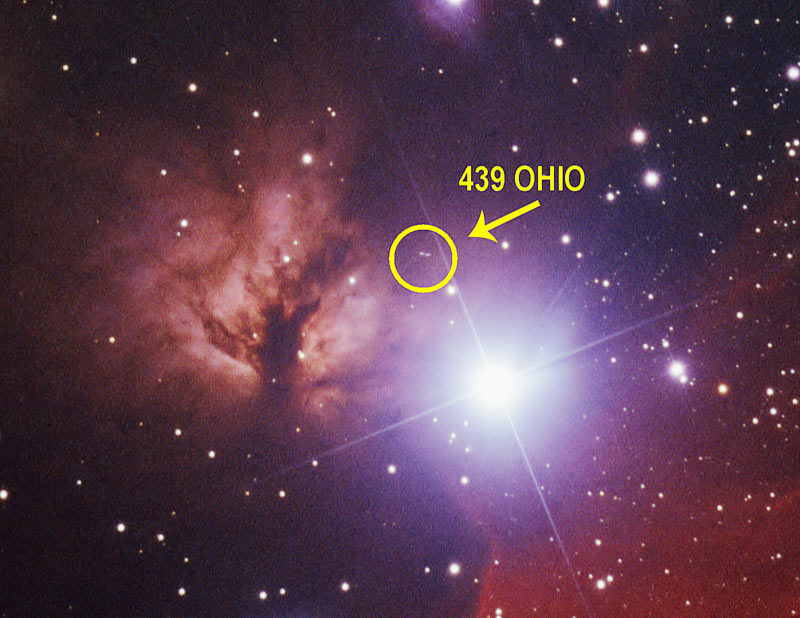
|
La nebulosa Fiamma (NGC 2024) e l'asteroide 439 Ohio The Flame Nebula (NGC 2024) and the asteroid 439 Ohio A.R. 05h41m00s - Decl. -01°50'00" |
|
Questa foto che illustra la stella Zeta Orionis e la vicina
nebulosa Fiamma è stata realizzata unendo due scatti
consecutivi di 40 minuti ciascuno. La prima esposizione è cominciata alle ore 00:32 TU del 12/12/2004 mentre la seconda è iniziata alle 1:16 TU del medesimo giorno. Sono state effettuate dal Monte Labro (GR) al fuoco diretto di un telescopio Vixen R200SS (200 mm F:4) su montatura EQ6 + Vixen Skysensor 2000PC. Le esposizioni, su pellicola Kodak E200 esposta a 200 ISO, sono state effettuate con inseguimento mediante rifrattore 102/500 in parallelo e autoguida SBIG ST4. Nella zona, in quelle sere, c'era un ospite in transito, l'asteroide 439 Ohio di magnitudine 14.3 (le due piccole linee indicano il suo passaggio all'interno del cerchio giallo). Successivamente le diapositive sono state scannerizzate con uno scanner dia Minolta Dimage Scan Dual III, e processata mediante applicazione di uno stretching, maschera sfocata e bilanciamento dei colori. This photo of the star Zeta Orionis and the Flame nebulaa in the Orion belt was realized joining two pictures of 40' each. The first started at 00:32 UT and the second at 1:16 UT of december 12, 2004 from Labro Mount, in Italy, near Grosseto, at the prime focus of a Vixen R200SS R200SS telescope (200 mm F:4) using a Syntha Eq6 mount plus Vixen Skysensor 2000PC. This photos were taken using a Kodak E200 film at 200 ISO with a autoguide Sbig ST4 on a small refractor 102/500. In this region, in those days, there was a "guest" in transit: the asteroid 439 Ohio (14.3 mag). The two small lines inside the yellow circle show the path of the asteroid. Then I scanned the slides with a Minolta Dimage Scan Dual III scanner, and processed the file with a stretching, an unsharp mask and, last, a color balance. The final sum was realized with Photoshop. |